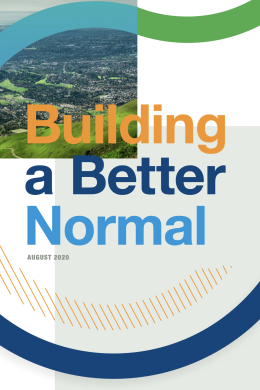Throughout history, natural and man-made disasters have wrought catastrophe upon communities — and spawned innovations that improved lives. From sewers and water conveyance systems to fire codes and building standards, societies have often responded to disasters with vision and investment that created better conditions for the public.
Leaders in Silicon Valley are looking at the innovations that might emerge in response to the COVID-19 pandemic. One thing is clear: This time, it won’t be an engineering solution. The Silicon Valley Recovery Roundtable, launched in May to help families and businesses get back to work, quickly realized that its goal was not to return to “normal” but to repair the systemic disparities that existed before the pandemic. The roundtable has released a report offering policy recommendations for how the South Bay can emerge from the current crisis as a more sustainable and more equitable community.
Disparate Impacts
Despite the general resilience of the tech economy and the relative ease for many high-skilled employees to transition to a virtual work experience, thousands of the most vulnerable in the Silicon Valley have been affected with reduced wages and eliminated positions. These workers, who support the innovation economy as hospitality, food service, construction or other front-line workers, were already severely cost-burdened when fully employed and have the least resilience to weather this storm. According to the report, 37% of Silicon Valley households have less than $25,000 in savings. And there are deep disparities when looking at race and ethnicity. Per capita income is $77,209 for white residents but just $22,601 for Hispanic or Latinx community members in Silicon Valley — a greater racial/ethnic disparity than in California or in the United States overall.
Because low-income workers are often those on the front lines, live in overcrowded conditions, may have underlying health conditions and may not have health insurance, these families have also been hardest hit directly by the virus. Residents in low-income zip codes have four times the death rate of those in non-low-income zip codes in Santa Clara County.
The bottom line is that immigrants, communities of color and undocumented workers have lost the most jobs and also experienced the highest infection rates.
Building a Better Normal
In response, leaders at all levels of government have established recovery committees around the country. These committees have investigated the specific impacts on their local communities and are identifying solutions to mitigate those impacts and restore economic activity. That was the charge for members of the Silicon Valley Recovery Roundtable when it launched in mid-May. San José Mayor Sam Liccardo convened the group of 59 Silicon Valley leaders from the business, education, labor and social sectors to chart an economic and social recovery in Santa Clara, San Mateo and southern Alameda counties.
The committee was co-chaired by: Bob Alvarado, executive officer of NorCal Carpenters Regional Council; Carl Guardino, CEO of the Silicon Valley Leadership Group; Chuck Robbins, chairman and CEO of Cisco; Lisa Su, president and CEO of AMD; and Nicole Taylor, president and CEO of the Silicon Valley Community Foundation.
The roundtable organized itself around four core questions:
1. How do we reduce risks and reopen safely and productively?
2. How do we make the recovery inclusive for our community’s most vulnerable members?
3. How do we enable businesses to survive and thrive?
4. How do we innovate to build the foundation of the new normal?
SPUR served as co-chair of the subcommittee looking at ways to make the recovery inclusive for the community’s vulnerable members. Over the course of 100 days, roundtable members, supported by consultants from Boston Consulting Group and Stanford Impact Labs, held scores of meetings and interviewed people directly affected by the pandemic, as well as subject-matter experts and nonprofit leaders providing direct services.
Centering our recovery recommendations on the most vulnerable in the community, we produced a set of solutions spanning from near-term to long-term that will drive job creation, support small business, expand digital inclusion, and protect and produce more housing.
With the final report published, the roundtable is now shifting its focus to implementation. This process brought together leaders across Silicon Valley and gave them a better understanding of just how much the business ecosystem depends on a healthy and vibrant community. It also revealed that the disparities in our community are unjust and systemic, and they will not be solved by an engineering or technology solution. Instead they will require social innovation and ongoing attention and investment by a cross-sector coalition to make a meaningful and lasting impact.
SPUR will continue to collaborate with those involved in the Silicon Valley Recovery Roundtable as well as those who've been working to address disparities across the region for decades.
